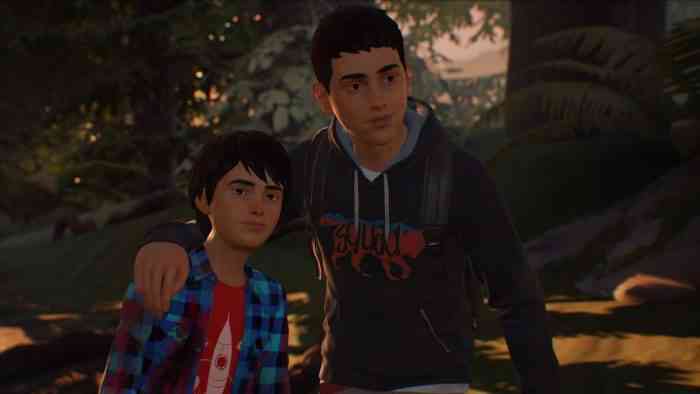Life is Strange 2 Review
The words “Life is Strange” are familiar ones by now, even if we aren’t so used to the “2” being tacked on at the end. With a different, unrelated story from the previous game that takes the trajectory away from characters we’d grown to love, the sequel treads new ground while making the familiar work in its favor. Life is Strange 2 or LIS 2, utilizes the first-person adventure genre more skillfully than Dontnod’s initial run, showing how much the developers have grown from game to game.
Episode 01 – Roads begins strong. Life is Strange 2 is story-oriented, and it is a difficult task to meaningfully talk about the game without saying about the actions and events within themselves. There are new protagonists, Mexican-American teenager Sean Diaz and his nine-year-old brother Daniel, who live in South Seattle. When a life-changing event that results in one of the brothers developing Max-like powers (but, like the rest of the game, they’re different than before, and much less involved), they find themselves on the run, traveling south towards the Mexican border.
Everything is Political, Sean
This is a game aware of its surroundings in a way the first was not. I mean this two-fold. First of all, for the most part, the teenagers sound like feasible people instead of what hipster aliens trying to pass themselves off as human might sound like. Of course, listening to Chloe say hella was part of the first game’s appeal, but Life is Strange 2 brings authenticity to the dialogue. Secondly, and more importantly, this game is created as a timestamp, not to date itself with bad lingo, but as a conscious reflection of the current tension in American society. The opening sequence wasn’t subtle, exactly, but it managed to show the effects of systemic racism without ever uttering the word, and it showcased how life, for those that are targeted, can go from relatively unscathed by the world to irrevocably changed in one instant.

The writing makes its point extremely clear in a few scenes after that, especially in one scene particular that could alternatively come off as either heavy-handed or a sign of how low America has gotten. As a Travis McElroy-esque podcaster says later in the episode, “Everything is political, Sean.” Regardless of the politics, however, the story organically builds the brotherly relationship between the characters, with Daniel learning what’s acceptable behavior from Sean. I sometimes winced at Sean’s casual cruelty to his little brother, wanting to make him take back his words, but that’s how siblings are, and the relationship that builds for them from this point forward can no longer be that of two brothers bickering with no real problems.
To say more about the plot would take away from it, except to say that the pacing does stumble a bit. After the initial title sequence it drags, but it picks back up and stays strong for the middle and end enough that I forgave it, appreciative of the story it was telling enough to forget a little tedium in the interim. The tension was unlike that of Max’s world in her first episodes, and I would compare the first episode of LIS 2 to being more akin to the original season of The Walking Dead than the first game, sans zombies (no matter how Daniel feels about the matter). It had a more grown-up feel, and the immediacy of the characters’ problems can’t be solved, only exacerbated, by the newfound powers.
Different Isn’t Bad
For someone expecting and wanting LIS 2 to be the exact same as last time, they might be disappointed, as there is no school and little high school drama. I think that’s unfair, however, as Dontnod hasn’t promised to bring us the same story, only to inhabit us in that world again. It definitely felt like the world of Arcadia Bay, with or without the nods to the original series. The powers are less involved for now, but I think the first game had a bad habit of leaning on the powers, while they now seem here to aid the story and not the other way around.
The animation has cleaned up since LIS Prime (a nickname I’ve come up with for it just now), making the backdrops even more stunning than before and thankfully cleaning up the sometimes stilted character models from the original. Now the people, for the most part, look like they fit in with the world they inhabit, which takes full advantage of the stunning landscapes of the Pacific Northwest. The controls are familiar, sans Max’s time backtracking, and Sean’s drawing is an interesting new mechanic that I enjoyed more than Max’s camera. The music didn’t grip me as much as it did before, but Max and Sean’s tastes in music are different, and I’m much closer to being a moody hipster teenage white girl than I to being a (still moody) teenage second-generation Mexican-American boy.
Overall, Life is Strange 2 was not only better than I expected, but I believe it would have been a hit even if no one had ever heard of the first game. It was beautiful, with the mechanics all improved on the original and the choices more meaningful than ever. I was disappointed with the ending of the first Life is Strange—the plot felt like it got away from itself, as though the game hadn’t been fully planned out when the first chapter was released—but I have faith that isn’t the case this time around. I want to know what happens to Sean and Daniel, even if it hurts to know, and that is the definition of great storytelling.
***PS4 code provided by the publisher***
The Good
- improved core mechanics
- strong, impactful storytelling
- stunning landscapes
- compelling voice acting
- interesting character dynamics
The Bad
- slightly uneven pacing
- occasionally heavy-handed
- music wasn’t as immersive

